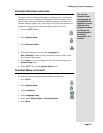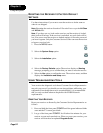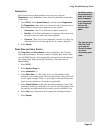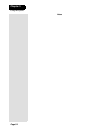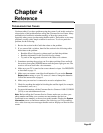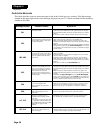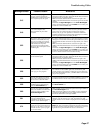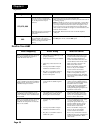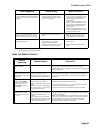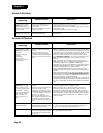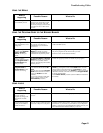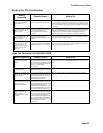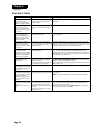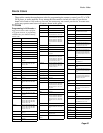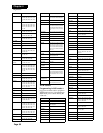
Troubleshooting Tables
Page 59
USING THE REMOTE CONTROL
When you run Check Switch, you see
"Twin" identified as the Device/LNB but
you only have signal confirmed from one
satellite.
• The DishPro Twin LNBF is
connected but the dish may not be
pointed to receive signal from both
110 and 119 satellites.
• If the check switch summary screen
shows "119 W" on Dish Input 2, you
need to point you dish 9 degrees to the
east and repeak your dish. Rerun
check switch.
If the check switch summary screen
shows "110 W" on Dish Input 1, you
need to point you dish 9 degrees to the
west and repeak your dish. Rerun
check switch.
Make sure the skew setting is correct
for a Dish 500 installation at your zip
code. Rerun check switch.
When you run Check Switch, you see
"Twin" identified as a Device or LNB,
but only odd transponders are detected.
• Cables may not be rated for 2150
MHz.
• Make sure cable is rated for 2150
MHz and all accessory devices are
compatible. Rerun check switch.
Getting receiver messages that signal is
lost or being acquired
• Check the weather conditions to see if
heavy rain or snow could be
temporarily block the signal.
• Check for any obstructions in way of
the dish like new growth on trees
• Wait for weather to clear up and
restore signal.
• Clear obstructions from the signal
path.
* Compatible accessory devices must pass 2150 MHz signals, 22 KHz signals both directions (per DiSEqC 2.0
specifications), and pass DC power.
What Is
Happening
Possible Reason What to Do
You cannot find the
remote control.
N/A Use the receiver front panel Control Buttons to control the
receiver until you find the remote. If the remote control is
permanently lost or too damaged to use, call the Service Center to
order a replacement.
When you press a button
on the remote control, the
receiver does not do what
you expect.
The remote control may be missing
batteries, the batteries may be
incorrectly placed in the remote, or
the batteries may be weak or dead.
If the batteries are missing or dead, insert fresh AAA-size batteries.
If the remote has fresh batteries, check whether they are placed
according to the label diagram. If not, remove them and place
correctly.
When you press the
remote control Power
button to turn the receiver
ON, the receiver front
panel Power light does
not light up.
Other lights are too bright.
Remote control not operating
properly or the batteries are weak or
dead.
The receiver power cord not plugged
into a power outlet, or there may be
a problem with the power.
Try other remote control buttons to see if the receiver is responding.
Replace the remote batteries with fresh ones.
Check that the receiver power cord is not damaged, and that the
plug is inserted correctly into the outlet.
See if the receiver turns on with the front panel power button.
You use a pyramid type IR
extender (not a “mouse
tail”), and it does not seem
to work.
The IR sensor on the extender that
receives the remote control signals
may not be facing the remote
control.
The IR cable on the extender that
sends the signal to the receiver may
not be right in front of the IR sensor
on the receiver front panel.
Make sure that the extender that receives the signal from the remote
control is facing the right way, so that the IR sensor can receive the
remote control signals.
Make sure that the IR cable on the extender that sends the signal to
the receiver is right in front of the IR sensor on the receiver front
panel, so that the receiver IR sensor can receive the signals.
If doing the above does not solve the problem, contact the
manufacturer of the extenders for assistance.
What’s Happening What’s Wrong What You Can Do



